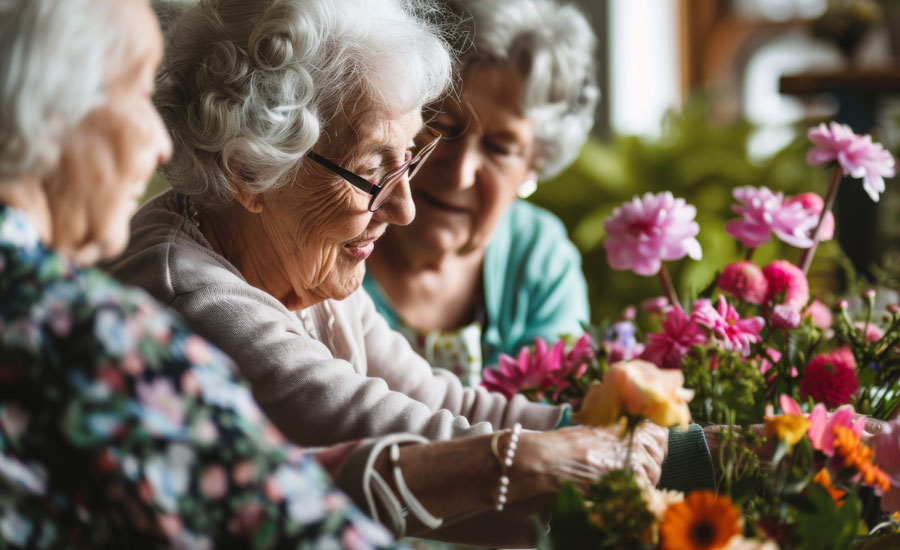The Secret to Staying Active and Social in a Residential Care Home

Moving into a care home doesn’t mean slowing down – quite the opposite! Residential care homes are packed with opportunities to stay active and social. From group activities to catching up over meals, there’s always something happening to keep your loved one engaged and feeling part of a community.
Keep reading to learn how care homes keep their residents socially active.
How Do Care Homes Keep Residents Socially Active?
Regular events like games, movie nights and themed parties are an easy way to help residents form connections. But how else do care homes meet social needs?
Scheduled Group Activities
Regular get-togethers like trivia nights, arts and crafts sessions and live music performances bring residents together in a natural and fun setting.
Shared Meals
Communal dining creates an informal, welcoming environment for residents to chat over cuppas, dinner or wine, fostering long-lasting friendships.
Casual Social Spaces
Lounges, patios and gardens offer relaxed interactions where residents can connect naturally throughout their day.
Staff Support
Carers actively encourage residents to join activities, ensuring no one feels left out, especially for more reserved residents.
Special Events and Outings
Day trips, festive celebrations and themed parties allow residents to socialise outside their usual routine.
The Role of Physical Activities in Social Engagement
Staying active is great for fitness. But it’s also fundamental to building connections in a care home. Exercise classes, like yoga, dancing or light aerobics, are a social hub where residents can chat, encourage one another and bond over shared interests.
Outdoor projects, from gardening to walking clubs, bring people together in nature, offering a refreshing way to stay active while engaging in meaningful conversations. Even simple games, like chair volleyball, create a strong sense of community by combining physical activity with a lighthearted competitive, friendly atmosphere.
Staying active in care homes boosts health while letting residents form deeper friendships and feel more connected to their fellow residents.
Creating Opportunities for Meaningful Connections
In addition to activities, residential care homes will put together events and trips to bring residents together naturally. Here are just a few ways they do this:
Special Interest Clubs – Good care homes often organise clubs based on favourite interests like book clubs, gardening groups or painting.
Volunteer-Led Programs – Care homes will set up pet therapy sessions, creative workshops or educational talks led by local volunteers.
Celebrating Milestones – Birthdays, festivities and notable achievements are celebrated together, reinforcing a strong sense of community where residents feel connected to one another.
Group Outings – Most care homes have a wheelchair-friendly minivan and organise regular trips to local parks, museums or shops, providing a fun way for residents to engage socially outside the care home, strengthening bonds through shared adventures.
How Care Homes Ensure Inclusivity
Care homes strive to make sure everyone can get involved, regardless of their physical or cognitive abilities. Here’s how they do it:
Tailored Activities
With a wide range of abilities in mind, activities are varied and diverse. So whether a resident prefers light physical games or quieter activities like puzzles, there’s something for everyone.
Staff Support
Care home staff actively help residents join in, offering gentle encouragement to those who might be hesitant or shy and ensuring those with mobility issues can participate comfortably.
Adaptable Options
Activities are often flexible and versatile, allowing for modifications based on individual needs. Whether it’s adjusting an art project or creating simpler versions of a game, the goal is to include everyone.
Feedback-Driven Programs
Residents are often asked for feedback, ensuring the care home tailors its offerings to suit their interests and preferences, which helps keep everyone engaged.
The Role of Technology in Keeping Residents Socially Engaged
- Virtual activities – Popular during the Pandemic, many care homes use technology to offer virtual events like live-streamed concerts or online fitness classes, giving residents more options to stay engaged.
- Staying connected with family – Choosing a care home with flexible visitation times is essential. But if you’re busy, tablets and video calls help residents stay in touch with family and friends, keeping them socially connected even when visitors can’t be there in person.
- Digital learning opportunities – Care homes sometimes offer technology classes to teach residents how to use devices, helping them engage with modern tools and stay mentally stimulated.
Individual Preferences
- One-on-one time – Staff often spend personal time with residents to engage their interests in a less overwhelming way, such as reading together or sharing personal stories.
- Alone time – Homes understand that each resident is different in terms of how they wish to socialise. Some may be more introverted and need more alone time than others, which is always respected.
- Rotating themes – Care homes sometimes rotate the focus of activities, such as themed weeks for music, movies or cultural explorations.
A Few Benefits of Social Activities in Care Homes
- Alleviates loneliness
- Lifts spirits
- Supports physical health
- Stimulates the mind
- Creates a sense of community
- Builds confidence
- Provides structure/li>
- Promotes learning
Socialising is the Key to Happiness in a Care Home
It all begins by choosing the right care home for your loved one. As well as medical and general care, a good home will make sure your loved one’s social needs are also taken of.
The opportunities to connect are endless. Whether through shared hobbies, special events or everyday conversations. Staying active and social is integral to care home life and is the heart of creating a happy, fulfilling experience.
